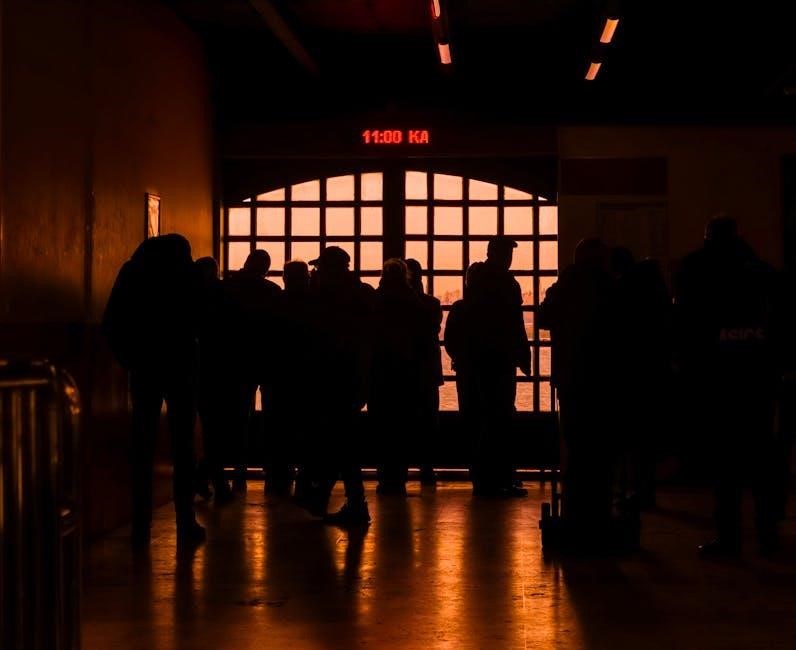Station Eleven, a captivating novel by Emily St. John Mandel, intertwines stories of survival, memory, and art amidst a global pandemic. The title reflects a comic book central to the narrative, symbolizing hope and resilience. This National Book Award finalist masterfully explores human connection and cultural preservation, resonating deeply with readers in a post-apocalyptic world.

Overview of the Novel
Station Eleven, written by Emily St. John Mandel, is a mesmerizing blend of post-apocalyptic fiction, drama, and speculative storytelling. Set in the Great Lakes region, the novel explores life before and after the devastating Georgia Flu pandemic. It weaves together multiple narratives, including Kirsten’s journey as a young actress, Arthur’s final days, and the enigmatic prophet’s rise. The story is deeply intertwined with a mysterious comic book, Station Eleven, symbolizing hope, art, and human resilience. This National Book Award finalist masterfully connects past, present, and future, offering a poignant reflection on survival, memory, and the enduring power of culture.
Importance of the Title “Station Eleven”
The title Station Eleven holds profound symbolic meaning, reflecting themes of survival, art, and interconnectedness. It refers to a mysterious comic book created by Miranda, Arthur Leander’s ex-wife, which becomes a beacon of hope for Kirsten; The title encapsulates the novel’s exploration of human resilience, blending the past, present, and future. It also symbolizes the enduring power of art to transcend chaos, connecting characters across time and space in a fragile, beautiful way.
Background of the Author
Emily St. John Mandel, born in Comox, British Columbia, Canada, developed a passion for art and literature early in life, influencing her unique storytelling style.
Emily St. John Mandel’s Biography
Emily St. John Mandel, born in Comox, British Columbia, Canada, grew up in the arts, studying dance before turning to writing. Her early career included indie presses, with her debut novel, Last Night in Montreal, published in 2009. Mandel gained widespread acclaim with Station Eleven in 2014, a National Book Award finalist. Her subsequent works, like The Glass Hotel, solidified her reputation as a masterful storyteller, blending literary depth with genre-defying narratives. Her unique voice continues to captivate readers globally.
Her Literary Career and Previous Works
Emily St. John Mandel’s literary career began with her debut novel, Last Night in Montreal, published in 2009. She gained recognition for her lyrical prose and intricate storytelling. Her subsequent works, The Singer’s Gun (2010) and The Lola Quartet (2012), explored themes of identity and morality. Mandel’s breakthrough came with Station Eleven (2014), a post-apocalyptic tale weaving art and survival, earning her a National Book Award nomination. Her later novel, The Glass Hotel (2020), further cemented her acclaim.

Key Themes in “Station Eleven”
The novel explores art’s role in survival, memory’s impact on resilience, and the interconnectedness of past, present, and future, weaving these themes into a profound narrative.
The Intersection of Art and Survival
In Station Eleven, art emerges as a vital means of survival, offering solace and meaning amidst collapse. Kirsten, a young performer, clings to Shakespearean roles, embodying the enduring power of culture. The Traveling Symphony, a nomadic theater troupe, preserves art as a beacon of humanity. The novel underscores how creativity sustains hope, fostering resilience and connection in a shattered world. Through this lens, Mandel illustrates art’s profound role in transcending catastrophe and reaffirming life’s beauty.
Memory and Its Role in Human Resilience
In Station Eleven, memory serves as both a burden and a lifeline, shaping characters’ identities and coping mechanisms. Kirsten’s fragmented recollections of Arthur Leander and her pre-pandemic life anchor her in a chaotic world. The Traveling Symphony’s performances become a collective memory, preserving culture and fostering unity. Memory, though painful, sustains hope and resilience, reminding survivors of their humanity and the beauty lost. It bridges the past and present, offering a path to rebuild and reconnect in a fractured society.
Connection Between Past, Present, and Future
In Station Eleven, the past, present, and future are intricately intertwined, reflecting the novel’s non-linear narrative. Memories of life before the Georgia Flu shape the characters’ identities in the post-apocalyptic world. The past informs their survival strategies and hopes for a future. Kirsten’s connection to Arthur Leander bridges timelines, while the Traveling Symphony’s performances symbolize the enduring power of art. This interplay underscores the resilience of humanity, emphasizing how the past illuminates the present and inspires the future.
Plot Structure and Narrative Style
The novel’s unique structure weaves together multiple timelines, blending the pre- and post-pandemic worlds. Its narrative style shifts seamlessly between characters, creating a rich, interconnected tapestry of stories.
Non-Linear Storytelling
The novel employs a non-linear narrative, jumping between timelines set before, during, and after the Georgia Flu pandemic. This structure intertwines the past and future, revealing connections between characters and events. The storytelling shifts seamlessly, creating a mosaic of memories and experiences. This approach emphasizes the enduring power of art and memory, while mirroring the fragmented nature of human resilience in the face of collapse. The non-linear style adds depth, layering themes of loss, hope, and rebirth.
Multiple Perspectives and Character Interwoven Lives
The novel masterfully weaves together multiple perspectives, creating a tapestry of interconnected lives. Characters like Kirsten, Arthur, Jeevan, and the Prophet each offer unique viewpoints, revealing how their paths intersect before and after the pandemic. This interwoven narrative highlights the emotional depth of each character and underscores the theme of human connection. By exploring diverse experiences, the story enriches its exploration of survival, memory, and the enduring power of art in a fragmented world.
The Georgia Flu and Its Impact
The Georgia Flu, a highly contagious and deadly pandemic, rapidly spreads worldwide, causing widespread death and societal collapse, reshaping humanity’s existence in “Station Eleven.”
Description of the Pandemic in the Novel
The Georgia Flu is a highly contagious and lethal pandemic that emerges suddenly, spreading globally with alarming speed. It is portrayed as a mutated influenza strain with extreme virulence, leading to rapid death in most cases. The virus is depicted as unstoppable, overwhelming medical systems and collapsing societies within weeks. Its origins are mysterious, adding to the chaos and fear. The flu’s impact is catastrophic, wiping out millions and plunging the world into a dark, post-apocalyptic era, leaving survivors to grapple with its devastating aftermath.
Societal Collapse and Human Behavior in Crisis

The Georgia Flu’s rapid spread triggers a catastrophic breakdown of society, with governments, economies, and social structures disintegrating. Chaos ensues as essential services fail, and lawlessness prevails. Communities fragment, and survivors often form small, distrustful groups. The novel explores how crisis reveals both the best and worst of humanity, with acts of kindness juxtaposed against violence and exploitation. The collapse forces individuals to confront their moral limits and the true meaning of survival in a shattered world.
The Role of Shakespeare in the Novel
Shakespeare’s plays serve as a lifeline, connecting survivors to humanity’s cultural heritage. Kirsten, a young actress, performs roles that symbolize resilience and hope amid devastation, reflecting universal themes.
His works transcend time, offering solace and meaning in a shattered world, embodying the enduring power of art to sustain the human spirit.
Shakespearean Themes and Symbolism
Shakespeare’s works in Station Eleven symbolize humanity’s enduring spirit. Plays like A Midsummer Night’s Dream and King Lear reflect themes of power, transformation, and redemption. The theater becomes a sanctuary, preserving culture and hope. Shakespeare’s exploration of human nature parallels the novel’s examination of survival, memory, and connection. His stories serve as a bridge between past and present, emphasizing art’s power to transcend chaos and unite people across time and circumstance.
Performances as a Form of Cultural Preservation
In Station Eleven, performances serve as a lifeline, preserving culture and humanity amid collapse. Kirsten and the Traveling Symphony perform Shakespeare and music, keeping art alive. These acts become rituals of remembrance, connecting survivors to the past. Performances transcend survival, offering hope and meaning. They remind people of their shared history and the beauty that persists, even in the darkest times, fostering resilience and unity in a fractured world.

Characters and Their Development
The novel intricately weaves diverse characters, exploring their growth and resilience. Each character’s journey reflects the emotional depth and interconnectedness of humanity, showcasing survival and transformation.
Kirsten and Her Journey
Kirsten, a young actress, survives the Georgia Flu and navigates a shattered world. Her journey symbolizes resilience, as she clings to art and memory. Carrying the “Station Eleven” comic, she embodies the novel’s themes of hope and cultural preservation. Kirsten’s development from a child to a determined survivor highlights the human spirit’s endurance. Her story intertwines with others, showcasing how art sustains humanity in the face of collapse. Kirsten’s path reflects the novel’s exploration of identity, loss, and the power of storytelling.
Arthur Leander and His Legacy
Arthur Leander, a renowned actor, dies on the eve of the Georgia Flu outbreak, leaving a complex legacy. His life, marked by personal struggles and relationships, is revealed through flashbacks. Arthur’s connection to Kirsten and the “Station Eleven” comic underscores his unintended influence. His death becomes a pivotal moment, symbolizing the collapse of the old world. Arthur’s existence and relationships shape the lives of others, creating a ripple effect that endures beyond his lifetime, emphasizing human connection in a fractured world.
The Prophet and His Influence
The Prophet, a charismatic and enigmatic figure, emerges in the post-apocalyptic world, wielding significant influence over a group of followers. His teachings blend mysticism and survival instincts, creating a cult-like dynamic. The Prophet’s true identity and motives are shrouded in mystery, adding depth to his character. His actions shape the lives of those around him, particularly Kirsten, leaving a lasting impact on the story’s moral and emotional landscape. His presence highlights humanity’s search for meaning in chaos.

Literary Devices and Symbolism
Emily St. John Mandel employs metaphors, allegories, and symbolic elements like the “Station Eleven” comic book, representing art’s power to transcend catastrophe and preserve memory.
The Use of Metaphors and Allegories
Emily St. John Mandel masterfully employs metaphors and allegories in Station Eleven, weaving vivid imagery to explore themes of survival and memory. The Georgia Flu serves as an allegory for real-world pandemics, reflecting societal collapse and human resilience. Kirsten’s journey mirrors a metaphorical quest for meaning in a fractured world. The “Station Eleven” comic book symbolizes art’s enduring power, bridging past and future. These devices enrich the narrative, offering deeper insights into humanity’s struggle to preserve culture amidst chaos.
The Significance of the “Station Eleven” Comic Book
The “Station Eleven” comic book is a central symbol of resilience and hope. Created by Miranda, Arthur Leander’s first wife, it becomes a cherished artifact for Kirsten, guiding her through the post-apocalyptic world. The comic’s narrative of survival and redemption mirrors the novel’s themes, emphasizing art’s enduring power. Its interstellar imagery reflects humanity’s quest for meaning, making it a poignant reminder of culture’s ability to transcend catastrophe and connect past, present, and future.
Reception and Awards
The novel was a National Book Award finalist and received widespread critical acclaim for its unique narrative and themes. It became a bestseller globally.
National Book Award Nomination
“Station Eleven” was nominated for the National Book Award in 2014, recognizing its literary excellence and unique storytelling. The novel captivated judges with its blend of post-apocalyptic themes and artistic reflection, standing out in the Fiction category. Though it did not win, the nomination significantly boosted its visibility and acclaim, solidifying its place as a modern literary masterpiece.
Critical Acclaim and Reviews
“Station Eleven” received widespread critical acclaim for its lyrical prose and intricate narrative structure; Reviewers praised its ability to weave together themes of art, memory, and survival. Many highlighted its unique blend of post-apocalyptic fiction and literary depth, calling it a “masterpiece” and a “hauntingly beautiful” exploration of human resilience. The novel resonated with readers for its emotional depth and its ability to bridge the past, present, and future in a world grappling with collapse.

Cultural and Historical Context
“Station Eleven” reflects on modern society’s vulnerabilities and resilience, drawing parallels to real-world pandemics and societal collapses. It explores the enduring power of art and culture in crises.
Comparisons to Real-World Pandemics
The Georgia Flu in Station Eleven mirrors real-world pandemics like COVID-19 and the Spanish Flu, highlighting societal collapse and human behavior in crisis. The rapid spread, overwhelmed healthcare systems, and societal fragmentation resonate with historical outbreaks. The novel reflects on humanity’s vulnerability, fear, and resilience, offering a haunting yet hopeful perspective on survival and adaptation during global crises, echoing the emotional and psychological impacts of real-world pandemics on individuals and communities.
Reflections on Modern Society
Station Eleven critiques modern society by exploring themes of connectivity, consumption, and the fragility of human systems. The Georgia Flu’s aftermath reveals how quickly societal structures collapse, exposing underlying inequalities and fears. The novel reflects on humanity’s dependence on technology and media, while also highlighting the enduring value of art and relationships. It serves as a cautionary tale, urging readers to appreciate the present and nurture resilience in the face of uncertainty.
Connection to Other Works by the Author
Emily St. John Mandel’s Station Eleven shares thematic links with her earlier novel, The Glass Hotel, both exploring interconnected lives and societal collapse. While Station Eleven delves into a post-apocalyptic world, The Glass Hotel examines the fallout of financial collapse, reflecting Mandel’s fascination with human behavior in crisis and the enduring power of stories to connect and transcend.
Links to “The Glass Hotel”
Emily St. John Mandel’s Station Eleven and The Glass Hotel share a thematic connection through their exploration of interconnected lives and societal collapse. While Station Eleven focuses on a post-apocalyptic world devastated by the Georgia Flu, The Glass Hotel delves into the consequences of financial collapse and identity theft. Both novels highlight Mandel’s fascination with how global crises reveal human resilience and the power of stories to transcend chaos. This link underscores her recurring interest in how individual and collective experiences intertwine across time and space, creating a mosaic of human existence. Mandel’s works often blur the lines between past, present, and future, illustrating the enduring impact of our choices and connections. The two novels, though distinct in setting, together offer a profound reflection on survival, memory, and the search for meaning in uncertain worlds.
Recurring Themes in Mandel’s Writing
Emily St. John Mandel’s works often explore interconnectedness, memory, and survival. In Station Eleven, these themes emerge through the Georgia Flu’s aftermath, while The Glass Hotel examines identity and financial collapse. Mandel frequently delves into how art and stories preserve humanity during crises, reflecting her belief in the enduring power of culture. Her writing consistently weaves together past, present, and future, emphasizing the resilience of human connections and the timeless relevance of creative expression.

Adaptations and Interpretations
Station Eleven has been adapted into a critically acclaimed TV series, exploring its symbolic themes and interconnected narratives. Fans and critics interpret its story as a reflection of resilience and the power of art in crises.
TV and Film Adaptation Possibilities
Station Eleven’s complex, interconnected narrative and vivid imagery make it a compelling candidate for TV and film adaptations. Its non-linear structure and multiple perspectives could translate into a visually stunning series or film. The story’s blend of drama, mystery, and speculative elements appeals to a broad audience. Potential adaptations could explore the novel’s themes of art, memory, and survival, offering fresh interpretations while staying true to its emotional core. This would allow viewers to experience the story in new, immersive ways.
Reader Theories and Fan Discussions
Station Eleven has sparked vibrant discussions among readers, with many theorizing about the novel’s deeper meanings. Fans often explore the symbolism of the “Station Eleven” comic book and its connection to the story’s themes of art and survival. Discussions frequently focus on the interconnectedness of characters and the fluidity of time. Readers also speculate about the prophet’s motivations and the long-term implications of the Georgia Flu. These debates highlight the novel’s complexity and its ability to inspire thoughtful reflection and creativity among its audience.
Educational and Analytical Resources
Station Eleven offers rich material for academic exploration. Discussion guides, critical essays, and teaching aids are widely available, aiding deeper analysis of its themes and structure.
Study Guides and Literary Analyses
Scholarly resources, including detailed study guides and in-depth literary analyses, are available online, offering insights into the novel’s complex narrative, themes, and symbolism. These materials explore Mandel’s unique storytelling style, character development, and the blending of past and present. Analysis focuses on themes like art, memory, and resilience, providing readers with a deeper understanding of the text. These guides are invaluable for students, educators, and book clubs seeking to explore the richness of “Station Eleven” in an academic context.
Academic Discussions and Essays
Scholars and literary critics have extensively explored “Station Eleven,” analyzing its themes, structure, and cultural relevance. Academic essays delve into Mandel’s use of non-linear storytelling, the symbolism of the comic book, and the intersection of art and survival. Discussions often focus on how the novel reflects human resilience and the importance of memory in rebuilding society. These analyses offer profound insights into the text, making it a rich subject for scholarly debate and exploration in academic circles.

Availability and Download Options
Station Eleven is widely available in PDF format on platforms like Amazon, Google Books, and authorized bookstores. Ensure to purchase from legitimate sources to support the author.
PDF Versions and Digital Platforms
Station Eleven is accessible in PDF format through reputable digital platforms like Amazon Kindle, Google Books, and Kobo. Many libraries offer e-book rentals via OverDrive. Ensure to download from authorized sources to avoid piracy and support the author. The novel is also available on platforms like Scribd and Apple Books, making it easy to read on various devices. Digital versions provide convenience, allowing readers to enjoy the story on e-readers, tablets, or smartphones.
Legitimate Sources for Purchase and Download
Station Eleven can be purchased from authorized retailers like Amazon, Barnes & Noble, and IndieBound. Digital downloads are available via Google Books, Apple Books, and Kobo. Ensure to buy from these platforms to support the author and avoid unauthorized versions. Hardcover, paperback, and e-book formats are widely available. Purchasing through legitimate sources guarantees quality and contributes to the author’s royalties, promoting fair intellectual property practices.

Reader Reviews and Recommendations
Station Eleven captivates readers with its emotional depth and interconnected stories. Fans praise its unique narrative style, blending hope and despair. A must-read for literary fiction enthusiasts.
Community Feedback and Ratings
Readers worldwide praise Station Eleven for its haunting beauty and profound themes. The novel holds a 4.5-star rating on Goodreads, with many applauding its unique storytelling. Fans highlight Kirsten’s resilience and the emotional depth of interconnected lives. Some describe it as a “masterpiece of contemporary literature,” while others note its relevance to modern crises. The PDF version is widely appreciated for its accessibility, making the story reach a broader audience. Critics, however, occasionally find the non-linear narrative challenging.
Recommendations for Similar Books
Readers who enjoyed Station Eleven often appreciate books blending post-apocalyptic themes with literary depth. The Road by Cormac McCarthy explores survival in a bleak world, while The Handmaid’s Tale by Margaret Atwood delves into societal collapse. The Glass Hotel, also by Emily St. John Mandel, offers interconnected stories of humanity. Fans may also enjoy World War Z by Max Brooks for its pandemic narrative or The Year of the Flood by Margaret Atwood for its dystopian reflections.
